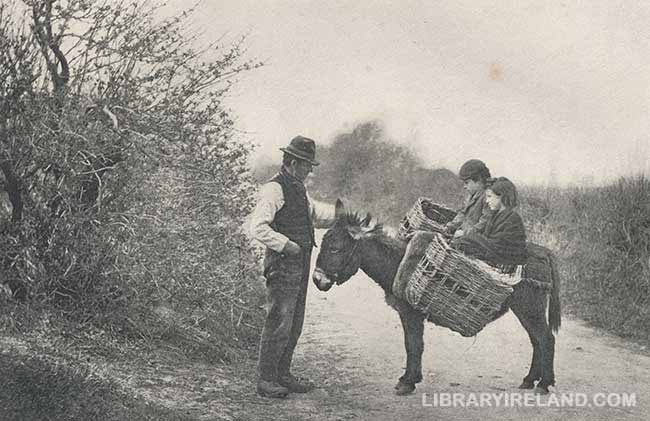Bundoran
Now we are on the road to Bundoran, and we had hardly cleared the skirts of Ballyshannon before it began to rain so hard that even had old Noah been with us he could not have bragged much about the Flood. It came in at our collars and went out at our boots. Our new driver could not be induced to say a single word except yes or no; he was neither a historian, a botanist, nor a geologist, and he took no interest whatever in ruins; but we forgave him for all these shortcomings, for he drove his horse steadily onward through the torrent with an unswerving perseverance that covered a multitude of sins. When we arrived at Bundoran's fashionable watering-place hotel, The Irish Highlands, the guests received us with shouts of laughter, in which we good-humoredly joined. No more weary pilgrims ever drew rein at inn in such a sorry plight.

Going to the Bog for Turf, Bundoran, County Donegal
Our clothes were dried during the night, and with a new steed we started for Sligo. It was clear weather and we had a pleasant ride along the coast-line. The feature of the day was skirting the base of Benbulbin for about seven miles. This is a most peculiar mountain, almost eighteen hundred feet high. Its base starts in with patches of yellow and sage-green verdure, then turns to streams of broken rocks. From these, regular pillars of stone start like the pipes of an organ, which can be seen for fifty miles, these again being covered by a flat crown of green growth. The whole looks like a vast temple in India. A large water-fall, consisting of three separate cascades, cuts its side and adds greatly to its beauty and attractiveness.
We passed through the village of Drumcliff, situated on the bank of the river of the same name which here enters Drumcliff Bay from Glencar Lake. A monastery was founded here by St. Columba, the site for which was given in 575, and it was made into a bishop's see, afterwards united to Elphin. This village was anciently called "Drumcliff of the Crosses," and of the remains of these the "Great Cross" is a fine example. It is thirteen feet high and three feet eight inches across the arms, which are connected by the usual circular segments. It is of hard sandstone and consists of three sections, the base, shaft, and top. It is highly sculptured, showing human figures, animals, and fine, interlaced scrollwork. There is also the stump of a round tower, about forty feet high, of rude masonry of the earliest group. The door is square-headed, six feet from the ground, and the walls are three feet thick.
Near Drumcliff was fought a great battle in 561, arising out of a quarrel over the possession of a copy of a Latin Psalter made by St. Columba from one borrowed of St. Finnian, of Moville. St. Finnian claimed the copy, and the case was brought before Dermot, King of Meath, who decided, Brehon fashion, that as "to every cow belongs its calf, so to every book belongs its copy," a judgment from which St. Columba appealed to his tribe. The party of St. Columba was victorious, three thousand of the men of Meath being slain. St. Columba was advised by St. Molaise to go to Scotland and convert the pagans as penance for the blood he had shed, which he did, and founded a missionary establishment in Iona.
Lord Palmerston took a great interest in this part of the country, laying out plantations in 1842 and building a harbor, which we saw from the car. It cost him over £20,000.
While riding along we noticed a tower on a distant hill, and said to the driver, "Is that a round tower?" "Yis, sur." "Are you sure it's round?" "Yis, sur, I am; it's square it is."
Read "On an Irish Jaunting Car through Donegal and Connemara" at your leisure
Read On an Irish jaunting Car through Donegal and Connemara at your leisure and help support this free Irish library.
Samuel Gamble Bayne was born in Ramelton, County Donegal, and educated at Queen's University in Belfast. At the age of twenty-five he left for America with a view to making his fortune. He invested in an oil well in Pennsylvania and later founded a bank which subsequently came to be the JP Morgan Chase bank in New York. By the time this book was written he was wealthy enough to be referred to as a billionaire. His account of the tour through the north, west and south of Ireland is a pleasant snapshot of how that part of the country was in the early part of the 20th century. He describes what is to be seen, gives some background history and, through the illustrations especially, provides wonderful glimpses of the area's social history.
The ebook is available in .mobi, .epub, and .pdf formats. See details ».

